The greenback traded higher against most of the other G10s, perhaps due to the ISM manufacturing PMI surprisingly signaling expansion. The big loser was the pound, which came under selling pressure on the disagreement between the EU and the UK with regards to whether the UK should abide to EU rules. The big winner was the Aussie, which received a boost after the RBA adopted once again a less-dovish-than-expected language.
ISM MANUFACTURING PMI SIGNALS EXPANSION
The dollar traded higher against most of the other G10 currencies on Monday and during the Asian morning Tuesday. It gained the most against GBP, NOK and CAD in that order, while it underperformed only versus AUD. The greenback was found virtually unchanged against NZD and SEK.
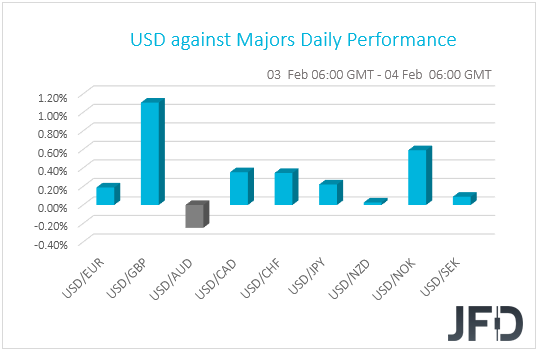
The dollar’s strength may be owed to the better than expected ISM manufacturing PMI for January. Expectations were for the index to increase somewhat but to stay stuck within the contractionary territory for the sixth straight month. Instead, it rose to 50.9 from 47.8, surprisingly exiting the below-50 zone, and thereby easing further concerns with regards to the US economy. Combined with this, a decent employment report on Friday may encourage market participants to push back the timing of when they expect the Fed to proceed with another rate decrease. Currently, according to the Fed funds futures, investors are still fully pricing in such an action to be delivered in July.

The surprise in the ISM may have been a boost for the US equity indices as well, all three of which closed in positive territory, aided also by gains in Amazon, Apple and Nike. That said, US indices were not the only ones closing in positive territory. EU bourses rebounded as well, perhaps after the PBoC decided to cut rates early Monday, and also to inject liquidity in order to support economic activity in light of the uncertainty surrounding the coronavirus. The improved investor morale rolled over into the Asian morning today as well, with Japan’s Nikkei 225 gaining 0.41%, and China’s Shanghai Composite adding 1.34% after tumbling 7.71% on its first trading day after the Lunar New Year Holiday.

As for our view, we find it very hard to say that the worst is behind us. The number of deaths due to the virus increased to 425 in China, while the cases surged to 20438. A second death outside China was also reported early today, this time in Hong Kong. Thus, for now, we would consider the latest recovery in risk assets as another corrective rebound. News and headlines that the measures adopted up until now have failed to contain the fast-spreading virus may prompt investors to abandon again equities and commodity linked currencies, in favor of the safe havens.
POUND SLIDES ON EU-UK DISAGREEMENT
Among the G10s, the pound was the big loser. Last week, the British currency enjoyed decent gains, topping the list of the G10 winners, perhaps due to the fact that the BoE kept interest rates unchanged, disappointing largely those expecting to get a rate reduction. With the focus turning back to the Brexit transition period, the pound took a 180-degree turn yesterday, with Cable falling nearly 200 pips. Remember that on Friday morning, we noted that the pound may continue enjoying some gains due to the BoE’s decision, but we expected it to slowly start being driven by data and headlines surrounding the transition period. It seems that this has been the case yesterday.
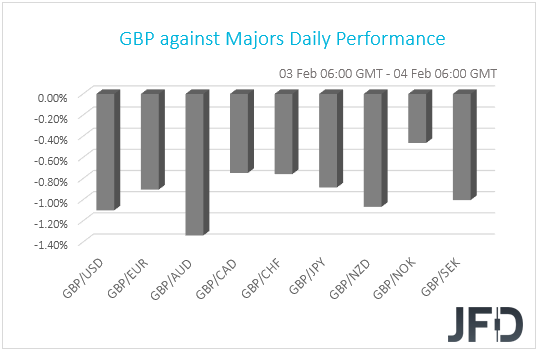
EU’s Brexit negotiator Michel Barnier said that they don’t want the UK to diverge from EU rules if the Britons actually want to have access to its single market. However, UK PM Johnson adopted a hard stance, replying that the UK will not adhere to the bloc’s rules and regulations, echoing recent comments by UK finance minister Sajid Javid. With Johnson insisting that the any agreement has to be reached before December, and the EU Commission President Ursula von der Leyen saying that it would be “basically impossible” to agree on everything by then, yesterday’s development suggest that the road towards a final accord may be bumpier than previously thought. In our view, all this disagreement keeps the risk of a disorderly exit at the end of this year well on the table, which is a negative force to the pound’s forthcoming course.
GBP/JPY – TECHNICAL OUTLOOK
Yesterday, after a strong move lower, GBP/JPY tested the lower bound of its range, which is between the 141.00 and 144.40 levels. This morning, we are seeing a small rebound from the lower side of the range. Although the pound had sharply fallen during yesterday’s trading session, given that the pair is still stuck within that range, we would need to wait for a confirmation break below the lower bound before examining a potential further move lower. This is why we will stay neutral, at least for now.
A strong move through the 141.00 zone would not only violate the lower end of the aforementioned range, but would also confirm a forthcoming lower low. Such a move might attract more sellers into the game and the rate may slide to the 139.98 area, which is the low November 26th. Initially, GBP/JPY could get a hold-up around there, or even correct back up again. That said, if the pair remains below the previously-mentioned 141.00 hurdle, this might result in another round of selling. If this time the 139.98 obstacle struggles to fight back the bears, its break may lead to a move to the 139.32 level, marked by the lows of November 11th and 22nd, 2019.
Alternatively, if the pair decides to travel back above the 142.67 barrier, which is an inside swing low of January 31st, this would place the rate above its 200 EMA and more buyers could see it as a good opportunity to jump in. If so, GBP/JPY may drift to the 143.28 hurdle, a break of which could clear the path to the upper bound of the aforementioned range, at 144.40.
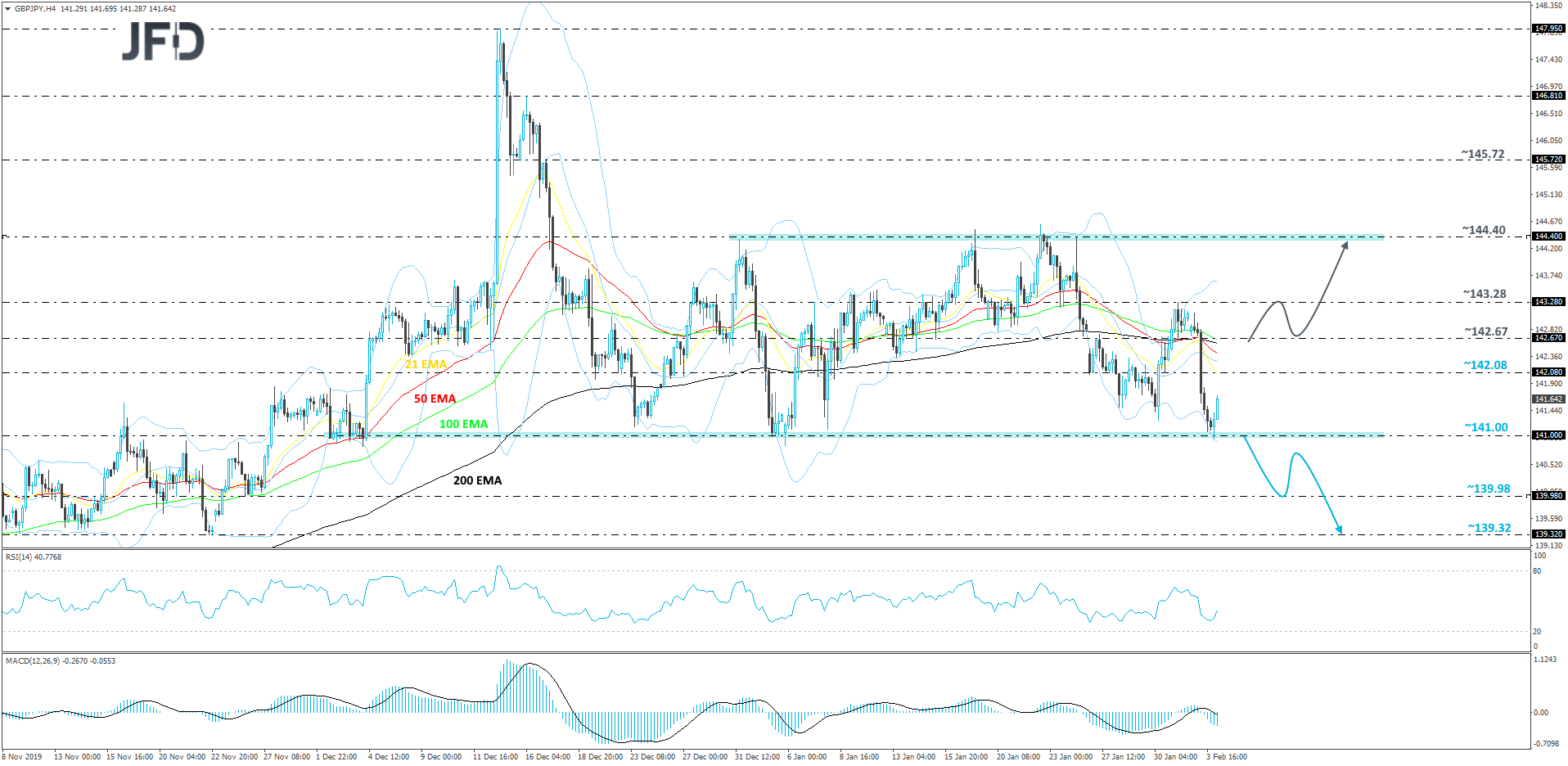
AUSSIE GAINS ON MORE SANGUINE RBA LANGUAGE
The big winner was the Australian dollar, which apart from the relative improvement in risk appetite, was also lifted by the RBA’s monetary policy decision and language, today during the Asian morning. The Bank decided to keep interest rates unchanged as was widely expected, but the statement accompanying the decision may have been once again less dovish than anticipated. The Bank noted that the central scenario is for the economy to grow by around 2.75% this year and 3% the next, which would be a step up compared to the past two years. Officials added that the bushfires and the coronavirus outbreak will weigh on domestic growth temporarily. They also noted that consumption growth is now expected to pick up gradually, and that inflation will soon reach 2% and fluctuate around there over the next couple of years. As for interest rates, they repeated that recognizing the long and variable lags in the transmission of monetary policy, the Board decided to hold the cash rate steady at this meeting, though they remain prepared to ease further if needed.
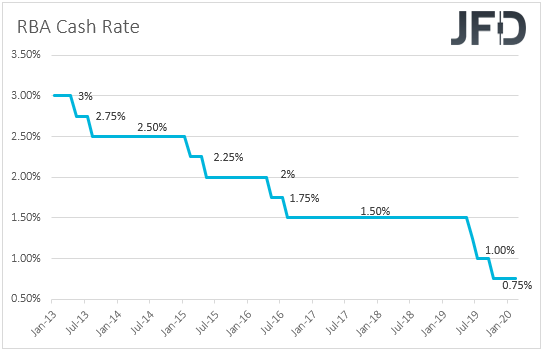
The somewhat sanguine statement confirms that officials are still comfortable on the sidelines, but despite buying some Aussies due to that, investors maintained the view that the RBA will indeed proceed with cutting rates again in May, at least according to the ASX 30-day Interbank cash rate futures yield curve. As for our view, we would consider the latest rebound in Aussie as a corrective move, of its larger downtrend. Investors still anticipate a cut, and as we noted above, we don’t think that the worst is over with regards to the coronavirus. So, bearing in mind the close trading relationship between Australia and China, we would expect the Aussie to slide again in case fears of further and faster virus spreading resurface. As we noted several times, during risk-averse periods, we would like to exploit any Aussie weakness against the yen. However, this time around, it can also underperform the Canadian dollar, even though the Loonie is also a commodity linked currency. The reason is simple and already mentioned. Australia can be impacted more from the effects of the coronavirus on the Chinese economy.
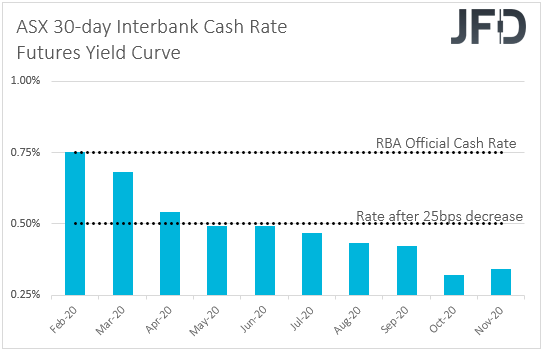
AUD/CAD – TECHNICAL OUTLOOK
On the last trading day of January, AUD/CAD found good support near the 0.8842 zone, from which it has now moved away to the upside. The pair is showing willingness to travel further north, but let’s not forget that the rate is still trading below its short-term tentative downside resistance line drawn from the high of December 31st. This is why for now, any move higher might be classed as a temporary correction before another leg of selling.
As mentioned above, the pair could continue with its journey to the upside, but if it finds it difficult to break the aforementioned downside line, we might see the sellers taking advantage of the higher rate and pushing it lower again. If so, we will target the area between the 0.8922 and 0.8931 levels, a break of which might set the stage for a move to the 0.8880 hurdle. That hurdle is marked near the high of January 31st and near an inside swing high of February 3rd.
On the other hand, if the previously-discussed downside line breaks and the pair travels above the psychological 0.9000 barrier, marked by the high of January 24th, this could lead to a change of the current downtrend and more bulls might get attracted. This is when we will start looking in the direction of the 0.9049 obstacle, which is the high January 23rd. If that area is just seen as a temporary pit-stop for the bulls, a further move up may lead to a test of the 0.9095 level, marked by the low of December 26th and an inside swing high of January 2nd.
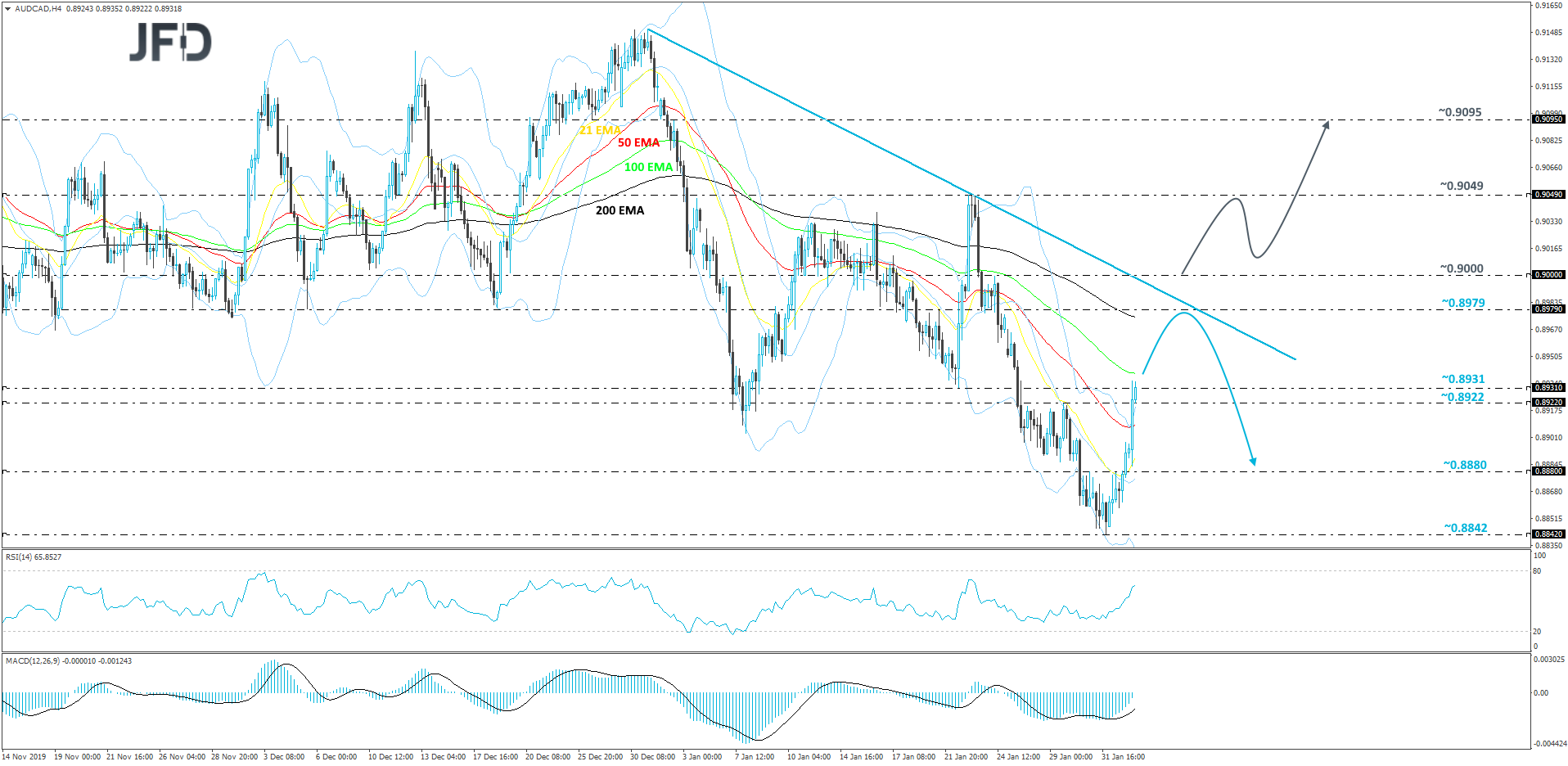
AS FOR THE REST OF TODAY’S EVENTS
From the Eurozone, we get the PPIs for December. The mom rate is expected to have ticked up to +0.3% from +0.2%, something that will drive the yoy rate up to -0.7% from -1.4%. From the UK, we get the construction PMI for January, which is expected to have risen to 46.6 from 44.4, while in the US, we have factory orders for December, which are anticipated to have rebounded to 1.2% mom after sliding 0.7%.
With regards to the energy market, we get the API (American Petroleum Institute) weekly report on crude oil inventories, but as it is always the case, no forecast is available.
As for tonight, during the Asian morning Wednesday, New Zealand’s employment report for Q4 is coming out. The unemployment rate is expected to have held steady at 4.2%, and the employment change to reveal an acceleration in added jobs, to +0.3% qoq from +0.2% in Q3. The labor cost index is expected to have slowed in quarterly terms, to +0.5% from +0.6%, but this would drive the yoy rate up to 2.4% from 2.3%.

At its November meeting, the RBNZ surprised investors, who were largely pricing in a rate cut, and instead decided to stand pat, keeping its rates at +1.0%. That said, they maintain an easing bias, saying that they will add further monetary policy stimulus if needed. Back then they noted that employment remains around its maximum sustainable level and thus, combined with the acceleration in the nation’s CPI rate to 1.9%, just a tick below the midpoint of the Bank’s target range of 1-3%, further improvement in labor market conditions may allow policymakers to wait a bit longer before they decide whether to cut interest rates further, or not. Having said all that, the big risk to that view is the fast-spreading coronavirus which could have a negative impact on New Zealand’s economy. Let’s not forget that New Zealand is one of China’s main trading partners.
